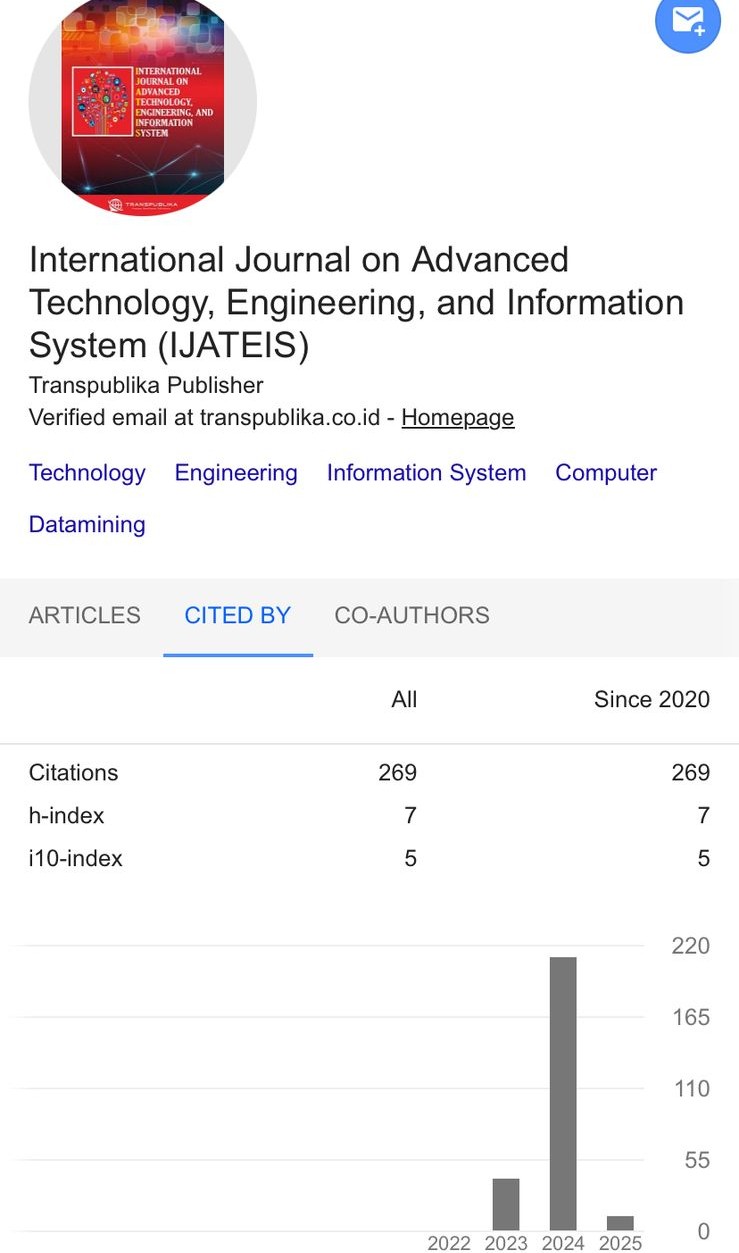Evaluation of Economic Feasibility by Using ETLE in Increasing Road User Compliance to Reduce Traffic Accident Rates
Main Article Content
Syahara Almas Safana*
This study aims to evaluate the effectiveness, efficiency, and economic benefits of implementing the Electronic Traffic Law Enforcement (ETLE) system in Indonesia, particularly within the context of digital transformation in traffic law enforcement. Using a quantitative approach based on survey instruments, the research model was developed through the integration of Benefit-Cost. Four key variables were examined: the quality of ETLE camera installation, operational efficiency, road user compliance, and supporting implementation factors. The survey instrument was comprehensively constructed and validated through expert judgment, involving both academics and ETLE practitioners. Data were collected from 115 respondents through both online and offline distribution methods, targeting road users and ETLE system administrators. The results of the analysis indicate that all variables significantly influence traffic law compliance. Operational efficiency was found to be a key mediating factor between installation quality and user compliance. Furthermore, the Benefit-Cost Analysis revealed a BCR value of 3.01, indicating that every Rp1 invested in the ETLE system yields a social and economic return of 3.01. This study asserts that the ETLE system not only enhances the accountability and efficiency of law enforcement but also significantly reduces potential state losses resulting from traffic violations and accidents. The practical implications of these findings provide a strong foundation for formulating sustainable digital transportation policies.
Abdullah, F. A., & Windiyastuti, F. (2022). Electronic Traffic Law Enforcement (ETLE) Sebagai Digitalisasi Proses Tilang. Jurnal Kewarganegaraan, 6(2). https://doi.org/10.31316/jk.v6i2.3242
Aguirre-Urreta, M. I., & Rönkkö, M. (2018). Statistical inference with PLSc using bootstrap confidence intervals. MIS Quarterly, 42(3), 1001-A10.
Aprianto, R., Nurrohman, H., Octavioliena, Z., & Ependi, A. (2025). Evaluating Effectiveness of ETLE and Designing ATCS Integration for Traffic Violation Reduction in Magelang Regency. Jurnal Teknologi Transportasi Dan Logistik, 6(1), 95–104.
Dupuit, J. (1844). On the measurement of the utility of public works. International Economic Papers, 2(1952), 83–110.
Ghozali, I. (2006). Aplikasi analisis multivariate dengan program SPSS. Badan Penerbit Universitas Diponegoro.
Lee, D. (2015). Absolute traffic: infrastructural aptitude in urban Indonesia. International Journal of Urban and Regional Research, 39(2), 234–250.
Marshall, A. (1890). Principles of economics: unabridged eighth edition 2009. Cosimo. Inc.
Pardede, C. R. V., Nita, S., & Setyabudi, C. M. (2022). Analisis Program Electronic Traffic Law Enforcement (Etle) Dalam Rangka Menciptakan Kamseltibcarlantas (Studi Kasus Kota Serang). Journal of Innovation Research and Knowledge, 1(8), 533–542.
Parker, D., Reason, J. T., Manstead, A. S. R., & Stradling, S. G. (1995). Driving errors, driving violations and accident involvement. Ergonomics, 38(5), 1036–1048.
Raihan, A., Voumik, L. C., Akter, S., Ridzuan, A. R., Fahlevi, M., Aljuaid, M., & Saniuk, S. (2024). Taking flight: Exploring the relationship between air transport and Malaysian economic growth. Journal of Air Transport Management, 115, 102540.
Sahu, P. K., Pani, A., & Santos, G. (2022). Freight traffic impacts and logistics inefficiencies in India: Policy interventions and solution concepts for sustainable city logistics. Transportation in Developing Economies, 8(2), 31.
Saibi, K. F., & Sihombing, S. M. (2024). The Effectiveness of the Electronic Traffic Law Enforcement (ETLE) Programme in Increasing Public Compliance in Medan City (Case Study of the Traffic Directorate of the North Sumatra Regional Police). Formosa Journal of Multidisciplinary Research, 3(1), 47–56. https://doi.org/10.55927/fjmr.v3i1.7523
Saida, M., Sultan, Lukman Setiawan Paris, D. A. Y., & Fahlevi, M. (2024). Exploring factors influencing actual usage of freight forwarding services in Indonesia: A study on desire, outcome expectations, perceived self-efficacy and moderating roles of delivery risk and perceived trust. GrowingScience.
Saunders, M., Lewis, P., & Thornhill, A. (2009). Research methods for business students. Pearson education.
Soehodho, S. (2017). Public transportation development and traffic accident prevention in Indonesia. IATSS Research, 40(2), 76–80.
Steg, L., & van Brussel, A. (2009). Accidents, aberrant behaviours, and speeding of young moped riders. Transportation Research Part F: Traffic Psychology and Behaviour, 12(6), 503–511.
Suriadi, E., Kristiawanto, & T. Paparang, S. (2022). Efektifitas Penerapan Tilang Elektronik Terhadap Pelanggaran Lalu Lintas Di Wilayah Hukum Polda Metro Jaya. POLICY, LAW, NOTARY AND REGULATORY ISSUES (POLRI), 1(2). https://doi.org/10.55047/polri.v1i2.83
Susanto, I. S. W., Aini, V. E. Q., Risqi, K. L., Khandari, M. A., & Kurniawan, A. (2022). Effectiveness of Implementing the ETLE Program in Following Traffic Violations. Int. J. Latest Res. Humanit. Soc. Sci, 5(12), 127–132.
Susilo, Y. O., Joewono, T. B., & Vandebona, U. (2015). Reasons underlying behaviour of motorcyclists disregarding traffic regulations in urban areas of Indonesia. Accident Analysis & Prevention, 75, 272–284. https://doi.org/https://doi.org/10.1016/j.aap.2014.12.016
Venardi, K. R. K., & Pambudi, A. (2024). Evaluasi Electronic Traffic Law Enforcement (ETLE) dalam Penindakan Pelanggaran Lalu Lintas oleh Direktorat Lalu Lintas Kepolisian Daerah D.I. Yogyakarta. JOURNAL OF PUBLIC POLICY AND ADMINISTRATION RESEARCH, 2(5).
Yuliantoro, Y., & Sulchan, A. (2021). The Effectiveness against Traffic Violations with Electronic Traffic Law Enforcement (ETLE). Law Development Journal, 3(4), 736–742.












